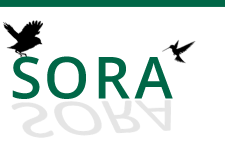Abstract
El Censo Neotropical de Aves Acuáticas (CNAA) arribó a sus 17 años de realización consecutiva en Venezuela durante el 2020. Durante este año los conteos se realizaron del 01 al 16 de febrero y del 04 al 19 de julio. Se contaron un total de 23.781 avistamientos (20.021 en febrero y 3.760 en julio), pertenecientes a 95 especies (92 en febrero y 40 en julio) y 19 familias, siendo las de mayor riqueza Scolopacidae y Ardeidae. Las especies residentes más abundantes fueron la Garcita Reznera Bubulcus ibis (3.318 avistamientos), el Yaguaso Cariblanco Dendrocygna viduata (2.337 avistamientos) y la Zamurita Phimosus infuscatus (1.486 avistamientos). Las especies migratorias mayoritarias fueron el Playerito Semipalmeado Calidris pusillla (N=636) y la Becasina Migratoria Limnodromus griseus (N=580). Se realizaron censos en 10 estados (10 en febrero, y tres en julio), para un total de 27 localidades, siendo el estado con mayor abundancia Apure, y los de mayor riqueza fueron Guárico y Zulia. Es importante resaltar que a pesar de las difíciles condiciones de logística y traslado motivados por la pandemia, el CNAAV se mantuvo, evidenciando el compromiso de los censistas en continuar con este importante proyecto.
The Neotropical Waterbird Census (CNAA) completed 17 years of consecutive survey efforts in Venezuela in 2020. Counts were conducted from February 1 to 16, and from July 4 to 19. A total of 23,781 individuals were counted (20,021 in February and 3,760 in July), belonging to 95 species (92 in February and 40 in July) and 19 families, the richest being Scolopacidae and Ardeidae. The most abundant resident species were the Cattle Egret Bubulcus ibis (3,318 sightings), the Black-bellied Whistling-Duck Dendrocygna viduata (2,337 individuals) and the Bared Faced Ibis Phimosus infuscatus (1,486 individuals). The main migratory species were Semipalmated Sandpiper Calidris pusilla (636 individuals) and the Short-Billed Dowitcher Limnodromus griseus (580 individuals). Surveys were carried out in 10 states (10 in February, and three in July), for a total of 27 surveyed localities. The state with the highest abundance was Apure, while the highest richness was detected in Guárico and Zulia. It is important to highlight that despite the difficult logistics and travel conditions due the pandemic, the CNAA survey efforts remained, evidencing the commitment of the volunteers to continue with this important project.
Creative Commons License
Recommended Citation
Sainz-Borgo, Cristina; Araujo-Quintero, Alexis; Angelozzi-Blanco, Gianco; Fernández-Ordóñez, Juan Carlos; Ferrebuz, José; Garay, Gaizkale; Hernández, Oswaldo; Luy, Alejandro; Martínez, Margarita; Silva, Sabino; Torres, Lermith; and Torres, Miguel Ángel
(2021)
"Censo Neotropical de Aves Acuáticas en Venezuela 2020 / Neotropical Waterbird Census in Venezuela 2020,"
Revista Venezolana de Ornitología: Vol. 11
:
Iss.
1
, Article 3.
Available at:
https://digitalcommons.usf.edu/rvo/vol11/iss1/3

